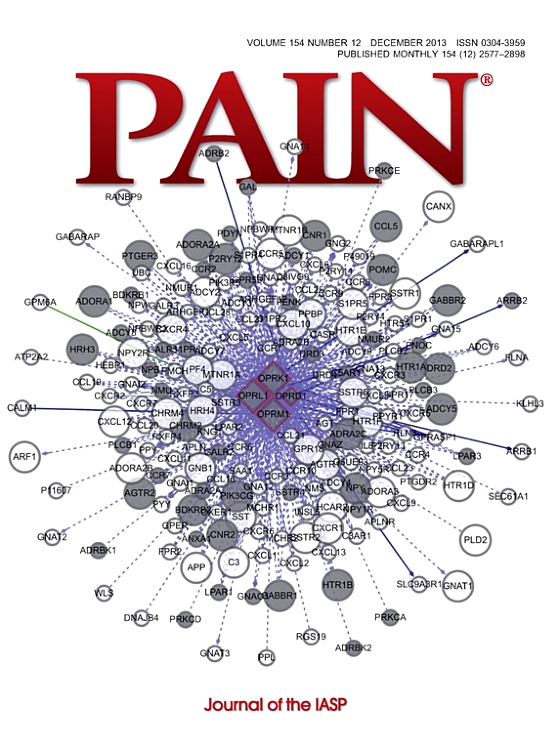Hsp90 inhibition in mouse spinal cord enhances Src kinase signaling in microglia to increase opioid antinociception.
IF 5.5
1区 医学
Q1 ANESTHESIOLOGY
引用次数: 0
Abstract
Opioid drugs are the gold standard for pain management, but have many serious drawbacks, which have highlighted the need for new approaches to improve opioid therapy. Previously, our lab discovered that Heat shock protein 90 (Hsp90), when inhibited in the spinal cord through intrathecal administration of 17-N-allylamino-17-demethoxygeldanamycin (17-AAG) in mice, led to an increase in morphine antinociception, which could enable an opioid dose-reduction strategy. In this study, we hypothesized that Src kinase was upregulated by 17-AAG treatment to cause this increase. To test this hypothesis, CD-1 mice were treated with 17-AAG and the Src inhibitor Src-I1 or Src CRISPR knockdown, followed by morphine. The enhanced antinociception seen with 17-AAG was completely abolished in the inhibitor groups in tail-flick and paw-incision pain models, suggesting that Hsp90 inhibition activates Src signaling to lead to enhanced opioid pain relief. Analysis by Western blotting showed upregulation of Src by 17-AAG treatment with the opioid agonist DAMGO, and also suggested that Src is upstream of extracellular signal-regulated kinase in this signaling cascade. Immunohistochemistry confirmed the upregulation of Src in the spinal dorsal horn and colocalization of activated Src with microglia. Inhibition of microglia with minocycline/PLX3397 mimicked the 17-AAG effects, while activation with lipopolysaccharide reversed them, suggesting that microglia could regulate these pain states. Finally, we used microglial-specific CRISPR knockdown to confirm that microglial Src is essential to the enhanced opioid antinociception observed with spinal Hsp90 inhibition. These observations elucidate a key molecular mechanism by which Hsp90 regulates microglia and opioid signaling, creating potential targets to improve opioid treatment.小鼠脊髓Hsp90抑制增强小胶质细胞Src激酶信号通路,增强阿片样物质抗感觉。
阿片类药物是疼痛管理的金标准,但有许多严重的缺点,这突出了需要新的方法来改善阿片类药物治疗。在此之前,我们的实验室发现,通过鞘内给药17- n -烯丙基氨基-17-去甲氧基格尔达霉素(17-AAG)抑制小鼠脊髓中的热休克蛋白90 (Hsp90),导致吗啡抗痛感增加,这可以实现阿片类药物剂量减少策略。在本研究中,我们假设Src激酶通过17-AAG处理而上调,从而导致这种增加。为了验证这一假设,用17-AAG和Src抑制剂Src- i1或Src CRISPR敲低治疗CD-1小鼠,然后用吗啡治疗。在甩尾和割爪疼痛模型中,17-AAG增强的抗疼痛感觉在抑制剂组中完全消失,表明Hsp90抑制激活Src信号导致阿片类疼痛缓解增强。Western blotting分析显示,阿片激动剂DAMGO处理17-AAG可上调Src,同时也表明Src在该信号级联中位于细胞外信号调节激酶的上游。免疫组织化学证实了Src在脊髓背角的上调和活化Src与小胶质细胞的共定位。米诺环素/PLX3397对小胶质细胞的抑制模拟了17-AAG的作用,而脂多糖的激活则逆转了这种作用,这表明小胶质细胞可以调节这些疼痛状态。最后,我们使用小胶质细胞特异性CRISPR敲低来证实小胶质细胞Src对脊髓Hsp90抑制观察到的阿片样物质抗感觉增强至关重要。这些观察结果阐明了Hsp90调节小胶质细胞和阿片信号传导的关键分子机制,为改善阿片治疗创造了潜在的靶点。
本文章由计算机程序翻译,如有差异,请以英文原文为准。
求助全文
约1分钟内获得全文
求助全文
来源期刊

PAIN®
医学-临床神经学
CiteScore
12.50
自引率
8.10%
发文量
242
审稿时长
9 months
期刊介绍:
PAIN® is the official publication of the International Association for the Study of Pain and publishes original research on the nature,mechanisms and treatment of pain.PAIN® provides a forum for the dissemination of research in the basic and clinical sciences of multidisciplinary interest.
 求助内容:
求助内容: 应助结果提醒方式:
应助结果提醒方式:


